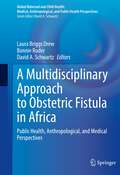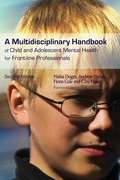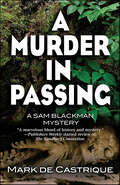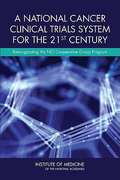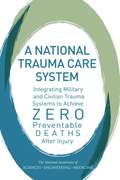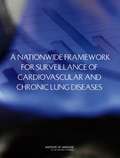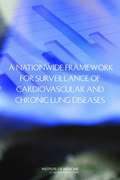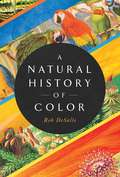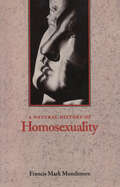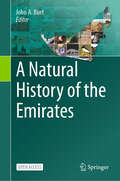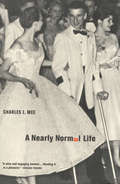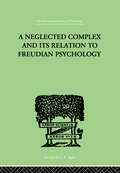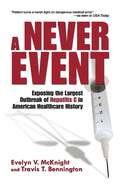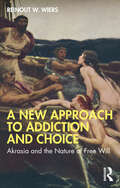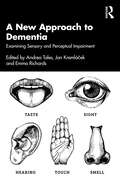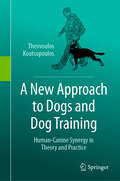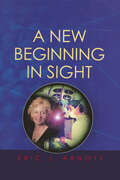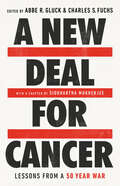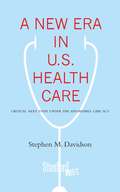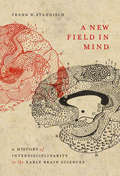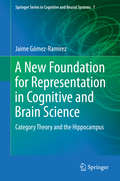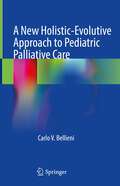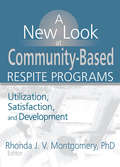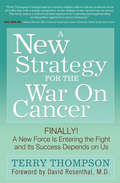- Table View
- List View
A Multidisciplinary Approach to Obstetric Fistula in Africa: Public Health, Anthropological, and Medical Perspectives (Global Maternal and Child Health)
by David A. Schwartz Laura Briggs Drew Bonnie RuderThis book applies a multi-disciplinary lens to examine obstetric fistula, a childbirth injury that results from prolonged, obstructed labor. While obstetric fistula can be prevented with emergency obstetric care, it continues to occur primarily in resource-limited settings. In this volume, specialists in the anthropological, psychological, public health, and biomedical disciplines, as well as health policy experts and representatives of governmental and non-governmental organizations discuss a scoping overview on obstetric fistula, including prevention, treatment, and reducing stigma for survivors. This comprehensive resource is useful in understanding the risk factors, epidemiology, and social, psychological, and medical effects of obstetric fistula.Topics explored include:A Human Rights Approach Toward Eradicating Obstetric FistulaObstetric Fistula: A Case of Miscommunication – Social Experiences of Women with Obstetric FistulaClassification of Female Genital Tract FistulasTraining and Capacity-Building in the Provision of Fistula Treatment ServicesDesigning Preventive Strategies for Obstetric FistulaSexual Function in Women with Obstetric FistulaSocial and Reproductive Health of Women After Obstetric Fistula RepairMaking the Case for Holistic Fistula CareAddressing Mental Health in Obstetric Fistula PatientsPhysical Therapy for Women with Obstetric FistulaA Multidisciplinary Approach to Obstetric Fistula in Africa is designed for professional use by NGOs, international aid organizations, governmental and multilateral agencies, healthcare providers, public health specialists, anthropologists, and others who aim to improve maternal health across the globe. Although the book’s geographic focus is Africa, it may serve as a useful resource for individuals who aim to address obstetric fistula in other settings. The book may also be used as an educational tool in courses/programs that focus on Global Health, Maternal and Child Health, Epidemiology, Medical Anthropology, Gender/Women's Studies, Obstetrics, Global Medicine, Nursing, and Midwifery.
A Multidisciplinary Handbook of Child and Adolescent Mental Health for Front-line Professionals: Second Edition
by Nisha Dogra Andrew Parkin Fiona Gale Clay FrakeThis fully updated edition of A Multidisciplinary Handbook of Child and Adolescent Mental Health for Front-line Professionals is an accessible introduction to child mental health, covering the nature, prevalence, treatment and management of mental health problems in children and young people. The authors explore issues such as assessing and meeting the mental health needs of young people, specific mental health problems such as attention deficit hyperactivity disorder (ADHD) and learning difficulties, and legal aspects of working with child mental health. They also assess diversity issues as an integral part of practice, and highlight practice issues for readers. The book contains illustrative case studies and self-directed exercises, and outlines the services available to children with mental health problems. This second edition also includes additional material on working with culture and diversity, plus the latest clinical guidelines and current medication. This handbook is an invaluable resource for students, trainers and professionals working with children with mental health problems in a medical and non-medical environment as well as parents wanting to know more about the subject.
A Murder in Passing (Blackman Agency Investigations)
by Mark de Castrique"This fascinating mystery, merging past and present, brings some little-known history to light and shows that laws change much faster than attitudes..." —BooklistThings are slow at the Blackman & Robertson Detective Agency. So when Nakayla Robertson suggests a mushroom hunt at the historic, freed-slave commune The Kingdom of the Happy Land, Sam Blackman reluctantly agrees. Hunting the elusive edible, he stumbles into a rotting log...with a skeleton hidden inside. He's intrigued, but local authorities tell him to butt out.Then Marsha Montgomery comes to Asheville asking Sam and Nakayla to investigate a 45-year-old burglary at her mother's home. Someone stole a rifle and a photograph taken in 1932 at The Kingdom of the Happy Land. Is this just a coincidence?Then Marsha's 85-year-old mother Lucille is arrested for murder, and Sam knows something is amiss. Is the skeleton that of Jimmy Lang, Lucille's lover and Martha's father, a white man who disappeared in 1967? A veil of betrayal and deceit hides a killer desperate to protect a dark secret, and not even Sam is safe from the deadly consequences of a murder in passing.
A National Cancer Clinical Trials System for the 21st Century: Reinvigorating the NCI Cooperative Group Program
by Institute of Medicine of the National AcademiesThe National Cancer Institute's (NCI) Clinical Trials Cooperative Group Program has played a key role in developing new and improved cancer therapies. However, the program is falling short of its potential, and the IOM recommends changes that aim to transform the Cooperative Group Program into a dynamic system that efficiently responds to emerging scientific knowledge; involves broad cooperation of stakeholders; and leverages evolving technologies to provide high-quality, practice-changing research.
A National Trauma Care System: Integrating Military and Civilian Trauma Systems to Achieve Zero Preventable Deaths After Injury
by Engineering Medicine National Academies of SciencesAdvances in trauma care have accelerated over the past decade, spurred by the significant burden of injury from the wars in Afghanistan and Iraq. Between 2005 and 2013, the case fatality rate for United States service members injured in Afghanistan decreased by nearly 50 percent, despite an increase in the severity of injury among U.S. troops during the same period of time. But as the war in Afghanistan ends, knowledge and advances in trauma care developed by the Department of Defense (DoD) over the past decade from experiences in Afghanistan and Iraq may be lost. This would have implications for the quality of trauma care both within the DoD and in the civilian setting, where adoption of military advances in trauma care has become increasingly common and necessary to improve the response to multiple civilian casualty events. Intentional steps to codify and harvest the lessons learned within the military’s trauma system are needed to ensure a ready military medical force for future combat and to prevent death from survivable injuries in both military and civilian systems. This will require partnership across military and civilian sectors and a sustained commitment from trauma system leaders at all levels to assure that the necessary knowledge and tools are not lost. A National Trauma Care System defines the components of a learning health system necessary to enable continued improvement in trauma care in both the civilian and the military sectors. This report provides recommendations to ensure that lessons learned over the past decade from the military’s experiences in Afghanistan and Iraq are sustained and built upon for future combat operations and translated into the U.S. civilian system.
A Nationwide Framework for Surveillance of Cardiovascular and Chronic Lung Diseases
by Committee on a National Surveillance System for Cardiovascular Select Chronic DiseasesChronic diseases are common and costly, yet they are also among the most preventable health problems. Comprehensive and accurate disease surveillance systems are needed to implement successful efforts which will reduce the burden of chronic diseases on the U. S. population. A number of sources of surveillance data--including population surveys, cohort studies, disease registries, administrative health data, and vital statistics--contribute critical information about chronic disease. But no central surveillance system provides the information needed to analyze how chronic disease impacts the U. S. population, to identify public health priorities, or to track the progress of preventive efforts. A Nationwide Framework for Surveillance of Cardiovascular and Chronic Lung Diseases outlines a conceptual framework for building a national chronic disease surveillance system focused primarily on cardiovascular and chronic lung diseases. This system should be capable of providing data on disparities in incidence and prevalence of the diseases by race, ethnicity, socioeconomic status, and geographic region, along with data on disease risk factors, clinical care delivery, and functional health outcomes. This coordinated surveillance system is needed to integrate and expand existing information across the multiple levels of decision making in order to generate actionable, timely knowledge for a range of stakeholders at the local, state or regional, and national levels. The recommendations presented in A Nationwide Framework for Surveillance of Cardiovascular and Chronic Lung Diseases focus on data collection, resource allocation, monitoring activities, and implementation. The report also recommends that systems evolve along with new knowledge about emerging risk factors, advancing technologies, and new understanding of the basis for disease. This report will inform decision-making among federal health agencies, especially the Department of Health and Human Services; public health and clinical practitioners; non-governmental organizations; and policy makers, among others.
A Nationwide Framework for Surveillance of Cardiovascular and Chronic Lung Diseases
by The National Academy of SciencesChronic diseases are common and costly, yet they are also among the most preventable health problems. Comprehensive and accurate disease surveillance systems are needed to implement successful efforts which will reduce the burden of chronic diseases on the U. S. population. A number of sources of surveillance data--including population surveys, cohort studies, disease registries, administrative health data, and vital statistics--contribute critical information about chronic disease. But no central surveillance system provides the information needed to analyze how chronic disease impacts the U. S. population, to identify public health priorities, or to track the progress of preventive efforts. A Nationwide Framework for Surveillance of Cardiovascular and Chronic Lung Diseasesoutlines a conceptual framework for building a national chronic disease surveillance system focused primarily on cardiovascular and chronic lung diseases. This system should be capable of providing data on disparities in incidence and prevalence of the diseases by race, ethnicity, socioeconomic status, and geographic region, along with data on disease risk factors, clinical care delivery, and functional health outcomes. This coordinated surveillance system is needed to integrate and expand existing information across the multiple levels of decision making in order to generate actionable, timely knowledge for a range of stakeholders at the local, state or regional, and national levels. The recommendations presented in A Nationwide Framework for Surveillance of Cardiovascular and Chronic Lung Diseasesfocus on data collection, resource allocation, monitoring activities, and implementation. The report also recommends that systems evolve along with new knowledge about emerging risk factors, advancing technologies, and new understanding of the basis for disease. This report will inform decision-making among federal health agencies, especially the Department of Health and Human Services; public health and clinical practitioners; non-governmental organizations; and policy makers, among others.
A Natural History of Color: The Science Behind What We See and How We See it
by Rob DeSalleA star curator at the American Museum of Natural History widens the palette and shows how the physical, natural, and cultural context of color are inextricably tied to what we see right before our eyes.Is color a phenomenon of science or a thing of art? Over the years, color has dazzled, enhanced, and clarified the world we see, embraced through the experimental palettes of painting, the advent of the color photograph, Technicolor pictures, color printing, on and on, a vivid and vibrant celebrated continuum. These turns to represent reality in &“living color&” echo our evolutionary reliance on and indeed privileging of color as a complex and vital form of consumption, classification, and creation. It&’s everywhere we look, yet do we really know much of anything about it? Finding color in stars and light, examining the system of classification that determines survival through natural selection, studying the arrival of color in our universe and as a fulcrum for philosophy, DeSalle&’s brilliant A Natural History of Color establishes that an understanding of color on many different levels is at the heart of learning about nature, neurobiology, individualism, even a philosophy of existence. Color and a fine tuned understanding of it is vital to understanding ourselves and our consciousness.
A Natural History of Homosexuality
by Francis Mark MondimoreSelected by Choice Magazine as an Outstanding Academic TitleA terrible sin, a gift from the gods, a mental illness, a natural human variation—over the centuries people have defined homosexuality in all of these ways. Since the word homosexual was coined in 1869, many scientists in a variety of fields have sought to understand same-sex intimacy. Drawing on recent insights in biology and genetics, psychiatrist Francis Mondimore set out to explore the complex landscape of sexual orientation.The result is A Natural History of Homosexuality, a generous work that synthesizes research in biology, history, psychology, and politics to explain how homosexuality has been understood and defined from ancient times until the present. Mondimore narrates tales of love and courage as well as discrimination and bigotry in settings as diverse as ancient Greece and Victorian England, early America and fin de siecle Vienna. He also tells fascinating stories about societies which accepted, incorporated, or institutionalized homosexuality into mainstream culture, stories illustrating that same-sex eroticism was often accepted as a normal aspect of human sexuality. In twentieth-century America, researchers first recognized that homosexuality might not be "pathological" when Alfred Kinsey and Evelyn Hooker conducted the first studies of sexuality not biased by preconceived notions of "normal" sexual behavior. After exploring sexual development in the human fetus, Mondimore reviews current biological research into the nature of sexual orientation and examines recent scientific findings on the role of heredity and hormones, as well as Simon LeVay's 1991 brain studies. He then turns to a very important focus: on people and their individual experiences. He explores "what happens between childhood and adulthood in an individual that makes him or her come to identify himself or herself as having a sexual orientation." He also explains our current understanding of bisexuality and the transgender phenomena of transsexualism and transvestism. Finally, Mondimore analyzes the circumstances of such prominent scandals as the anti-homosexual trials of Oscar Wilde and Philip von Eulenberg, and recounts the Nazi persecution of homosexuals during the Holocaust. This far-reaching discussion includes a description of the ex-gay ministries and reparative therapy as well as the Stonewall riots and AIDS, ending with the emergence of gay pride and community.
A Natural History of the Emirates
by John A. BurtFor many people, thoughts of the United Arab Emirates conjure images of ultramodern skyscrapers and rolling sand dunes. However, the Emirates are a rich mosaic of ecosystems and habitats that support surprisingly diverse communities of organisms, and there is growing awareness of the importance of these previously underappreciated natural assets. A Natural History of the Emirates provides a comprehensive overview of the unusual environmental setting of this young nation, and surveys the major ecosystems and the marine and terrestrial organisms occurring across the nation. From freshwater streams in the hyperarid Hajar Mountains to the world’s most temperature-tolerant coral reefs, the UAE is home to an astounding variety of uniquely adapted organisms that are providing insights into climate change and how organisms cope with and respond to extreme environmental conditions. The book closes with a section on human interactions with this unique environment, and proposes initiatives to ensure the protection of these unique natural assets into the future. This is an open access book.
A Nearly Normal Life: A Memoir
by Charles L. MeeIn the summer of 1953 the author was a carefree, athletic boy of fourteen. But after he collapsed during a school dance one night, he was suddenly bedridden, drifting in & out of consciousness, as his body disintegrated into a shadow of its former self. He had been stricken with spinal polio. When he emerged from the grip of the disease, he was confronted with a life change so enormous that it challenged all he had believed in & forced him, despite his young age, to redefine himself. His once stereotypically normal life, filled with baseball & swimming pools & dreams of girls, had been irreversibly altered. He was almost the same person he had been; he was nearly normal. His moving personal narrative is a textured portrait of life in the fifties - a time when America & her fighting spirit collided with this disease. Both funny & profound, he is a gifted, unique writer, who unravels the mysteries of youth in a Cold War climate, who gives voice to the mind of a child with a potentially fatal disease, & whose recognition of himself as a disabled outsider heightens his brilliant talents as a storyteller.
A Neglected Complex And Its Relation To Freudian Psychology (International Library Of Psychology Ser.)
by Bousfield, W RFirst Published in 1999. Routledge is an imprint of Taylor & Francis, an informa company.
A Never Event: Exposing the Largest Outbreak of Hepatitis C in American Healthcare History
by Evelyn V. McKnight Travis T. BenningtonCANCER CLINIC CAUSES WORST HEPATITIS OUTBREAK IN US HISTORY <p><p>In the small farming community of Fremont, Nebraska, townspeople eagerly welcomed an acclaimed doctor as the first full-time oncologist at their new cancer treatment center—but the fanfare soon turned into a nightmare. During chemotherapy treatments, 857 patients who were already waging the fights of their lives against cancer, were inexplicably exposed to the deadly, blood-borne hepatitis C virus. At least ninety-nine of them contracted the lethal illness. The horror was unprecedented—this was the largest healthcare-transmitted outbreak of hepatitis C in American history.
A New Approach to Addiction and Choice: Akrasia and the Nature of Free Will
by Reinout W. WiersThis engaging book provides a novel examination of the nature of addiction, suggesting that by exploring akrasia—the tendency to act against one’s better judgement—we can better understand our addictive behaviors. It offers an alternative to the dominant biomedical model of addiction as a chronic brain disease by looking at the nature of how we make decisions and proposing the idea that biased choice is central to addiction.The book looks at both classic substance use disorders and newer “addictions” to smartphones, meat and fossil fuels. It discusses current perspectives on free will in philosophy, psychology and neuroscience, and the questions surrounding free will versus determinism, including our ability to steer our behaviors guided by the promise of future outcomes. Different perspectives on addiction and choice are presented in an eloquent style, and illustrated by personal stories. Through a lively discussion of the key scientific and philosophical issues surrounding addiction, this book is valuable for students in psychology, criminology, sociology and social work, as well as health care professionals and general readers interested in the nature of our free will.
A New Approach to Dementia: Examining Sensory and Perceptual Impairment
by Emma Richards Andrea Tales Jan KremláčekA New Approach to Dementia: Examining Sensory and Perceptual Impairment is a groundbreaking work which highlights the non-memory impairments of the dementias to improve both early recognition of dementia and clinical diagnosis, as well as interventions and care. It focuses clinical attention on the significant evidence supporting the existence of many types of sensory and perception-related changes/abnormalities sometimes at the early stages of the disease and throughout its progression.Providing a holistic overview of the field, the book includes self-reports of people with dementia and caregivers, alongside an in-depth discussion of the application of the findings about non-memory impairments to clinical care and management. It leads a movement to address the over-focus on memory function in dementia and ageing, arguing for the need to test sensory and perceptual abnormalities to improve clinical practice and research into, and the care and support of, people living with dementia and associated disorders.With its mix of scientific, and clinical and real-life relevance, this book is essential for clinicians and researchers specialising in ageing and dementia as well as carers working with people living with dementia and students of neuropsychology/neurocognition, medicine and health and social care.
A New Approach to Dogs and Dog Training: Human-Canine Synergy in Theory and Practice
by Theovoulos KoutsopoulosThis book presents a new and innovative concept in dealing with dogs: the human-canine synergy (HCS), characterized by a holistic nature and its differentiation from unidimensional terms expressing the affiliation of humans and dogs (Relationship, Interaction, Bonding). Related to the use and training by humans, it applies three main categories of dogs: a) the empathy/therapeutic individuals, which are dogs helping persons with empathy- or therapeutic needs; b) assisting/working dogs carrying out specific actions to aid or assist humans perform specific tasks; and c) the facilitating/inspiring dogs, which enable or improve various human activities, including classroom dogs for teaching and learning purposes in almost all educational subjects.Organized in three parts, chapters address the following needs:• The first section illuminates the concept of HCS as well as basic principles determining this synergy and consequently the process of training dogs (owners and professional trainers). Readers will understand the role of a dog's personality, behavior and especially temperament in its successful training.• In a scientifically documented way, the second part guides those who wish to engage in dog training (amateur or professional). It describes basic training forms within the HCS framework (obedience, protection, detection and classroom dog) and necessary steps for proper completion.• The third book part describes the business of dog training with multi-dimensional approach by emphasizing a good understanding and knowledge of interactions and the environment in which trainer, owner and dog typically operate.Overall, this work is a valuable read for anyone who deals with our four-legged companions for business or pleasure.
A New Beginning in Sight
by Eric J ArnottConsultant eye surgeon, Eric Arnott, was one of the original pioneers of small-incision surgery. He was the first to perform modern Phaco surgery in Europe and designed lens implants that have restored the sight to millions of patients. The word autobiography is simply insufficient to describe this book, which is a remarkable testament to the life, works and marriage of a remarkable man.The book details the original invention of the lens implant by Harold Ridley, who Eric worked with in his early years of medical training. It goes on to follow the development of small-incision Phaco surgery, instigated by Charlie Kelman, and the disinterest and contempt held by the peers of these ophthalmologic pioneers. The author describes every advance in this field of ophthalmology in fascinating detail. The importance to Eric of religion, spirituality, family life and helping others less fortunate than himself is reinforced in this enthralling and at times very amusing read. Arnott draws you into his narrative, rousing thoughts of disbelief as you are compelled to continue reading, each new chapter and event in his life proving as fascinating as the last.Entertaining and illuminating, A New Beginning in Sight provides a detailed history of ophthalmology and is essential reading for ophthalmologists, other specialists and non-specialists alike.
A New Deal for Cancer: Lessons from a 50 Year War
by Abbe R. Gluck and Charles S. FuchsAn unprecedented constellation of experts—leading cancer doctors, policymakers, cutting-edge researchers, national advocates, and more—explore the legacy and the shortcomings from the fifty-year war on cancer and look ahead to the future.The longest war in the modern era, longer than the Cold War, has been the war on cancer. Cancer is a complex, evasive enemy, and there was no quick victory in the fight against it. But the battle has been a monumental test of medical and scientific research and fundraising acumen, as well as a moral and ethical challenge to the entire system of medicine. In A New Deal for Cancer, some of today&’s leading thinkers, activists, and medical visionaries describe the many successes in the long war and the ways in which our deeper failings as a society have held us back from a more complete success.Together they present an unrivaled and nearly complete map of the battlefield across dimensions of science, government, equity, business, the patient provider experience, and more, documenting our emerging understanding of cancer&’s many unique dimensions and offering bold new plans to enable the American health care system to deliver progress and hope to all patients.
A New Era in U.S. Health Care: Critical Next Steps Under the Affordable Care Act
by Stephen M. DavidsonA New Era in U.S. Health Care demystifies the Affordable Care Act for unfamiliar readers, setting an agenda for lawmakers and the health industry alike. It focuses on four key issues that will determine the success of this 2010 legislation: the use of state-run Medicaid programs to expand access to insurance; the implementation process; the creation of health insurance exchanges; and the introduction of a new organizational form, accountable care organizations.
A New Field in Mind: A History of Interdisciplinarity in the Early Brain Sciences (McGill-Queen's/Associated Medical Services Studies in the History of Medicine, Health, and Society #52)
by Frank W. StahnischIn recent decades, developments in research technologies and therapeutic advances have generated immense public recognition for neuroscience. However, its origins as a field, often linked to partnerships and projects at various brain-focused research centres in the United States during the 1960s, can be traced much further back in time. In A New Field in Mind Frank Stahnisch documents and analyzes the antecedents of the modern neurosciences as an interdisciplinary field. Although postwar American research centres, such as Francis O. Schmitt's Neuroscience Research Program at MIT, brought the modern field to prominence, Stahnisch reveals the pioneering collaborations in the early brain sciences at centres in Germany, Austria, and Switzerland in the first half of the twentieth century. One of these, Heinrich Obersteiner's institute in Vienna, began its work in the 1880s. Through case studies and collective biographies, Stahnisch investigates the evolving relationships between disciplines – anatomy, neurology, psychiatry, physiology, serology, and neurosurgery – which created new epistemological and social contexts for brain research. He also shows how changing political conditions in Central Europe affected the development of the neurosciences, ultimately leading to the expulsion of many physicians and researchers under the Nazi regime and their migration to North America. An in-depth and innovative study, A New Field in Mind tracks the emergence and evolution of neuroscientific research from the late nineteenth century to the postwar period.
A New Foundation for Representation in Cognitive and Brain Science: Category Theory and the Hippocampus (Springer Series in Cognitive and Neural Systems #7)
by Jaime Gómez-RamirezThe purpose of the book is to advance in the understanding of brain function by defining a general framework for representation based on category theory. The idea is to bring this mathematical formalism into the domain of neural representation of physical spaces, setting the basis for a theory of mental representation, able to relate empirical findings, uniting them into a sound theoretical corpus. The innovative approach presented in the book provides a horizon of interdisciplinary collaboration that aims to set up a common agenda that synthesizes mathematical formalization and empirical procedures in a systemic way. Category theory has been successfully applied to qualitative analysis, mainly in theoretical computer science to deal with programming language semantics. Nevertheless, the potential of category theoretic tools for quantitative analysis of networks has not been tackled so far. Statistical methods to investigate graph structure typically rely on network parameters. Category theory can be seen as an abstraction of graph theory. Thus, new categorical properties can be added into network analysis and graph theoretic constructs can be accordingly extended in more fundamental basis. By generalizing networks using category theory we can address questions and elaborate answers in a more fundamental way without waiving graph theoretic tools. The vital issue is to establish a new framework for quantitative analysis of networks using the theory of categories, in which computational neuroscientists and network theorists may tackle in more efficient ways the dynamics of brain cognitive networks. The intended audience of the book is researchers who wish to explore the validity of mathematical principles in the understanding of cognitive systems. All the actors in cognitive science: philosophers, engineers, neurobiologists, cognitive psychologists, computer scientists etc. are akin to discover along its pages new unforeseen connections through the development of concepts and formal theories described in the book. Practitioners of both pure and applied mathematics e. g. , network theorists, will be delighted with the mapping of abstract mathematical concepts in the terra incognita of cognition.
A New Holistic-Evolutive Approach to Pediatric Palliative Care
by Carlo V. BellieniThis book illustrates why a holistic approach is important in Pediatric Palliative Care (PPC). Readers will learn this approach has a “horizontal” axis, featuring the patients’ mental and physical needs, as well as their environments. It has also a “vertical axis”: the evolutive changes of the patients throughout their development and their illness, their aspirations and fears. An evolutive (or dynamic) approach is mandatory. Each child/parent has a different experience of illness and a different path to recovery that is influenced by their age, gender, culture, but also by the state of their grief. To take care of them, we need to know the state of the subjects we are dealing with throughout their evolution in age (children) and in sorrow (both children and parents). Jung’s and Piaget’ schemes will be of support. This book also helps caregivers to know what ethics is. It teaches a new insight on the word “ethics”: not a series of principles or norms, but an approach based on humanistic virtues. Two criteria will be proposed to this aim: an ethics based on the refusal of inauthentic behaviors (or those behaviors that are copies of animals or machines) and a new criterion that even children have some ethical duties (not based on rules, but on naturally acceptance that their sight is modulated by the presence of their parents and friends). This ethical approach is explained to caregivers in a practical mode, ready for clinical exigencies. This book is also unique because it demonstrates that PPC also involves the true care of caregivers. It will explain how to approach, measure and overcome caregivers’ burn-out. Special attention is devoted to the approach to babies’ and children’s pharmacological and non-pharmacological analgesia and sedation. Pain assessment methods will be illustrated, as well as the development of a PPC web on the territory. This text includes perinatal and neonatal PPC. The book will be of valuable support to all those intensivists, pediatricians, nurses, psychologists, physiotherapists and healthcare professionals working in PPC units.
A New Look at Community-Based Respite Programs: Utilization, Satisfaction, and Development
by Rhonda J.V. MontgomeryExplore new frontiers in Alzheimer's support systems! When Congress authorized the Alzheimer's Disease Demonstration Grants to States program in 1990, no one knew how effective the program would prove to be. A New Look at Community-Based Respite Programs provides you with results of the first major evaluation of ADDGS programs. Across the country, groups were able to develop specialized programs that reached traditionally underserved clients. A byproduct of many of the ADDGS programs was that they helped strengthen ties between communities and agencies, improving social services for both caregivers and people with Alzheimer's. A New Look at Community-Based Respite Programs examines: the profile of the average respite care user different challenges faced by urban and rural clientele how culture and ethnicity influence health care decisions ways to involve communities in respite care how understanding patterns of use makes for better program design and implementation A New Look at Community-Based Respite Programs provides you with detailed analyses of a variety of successful support service plans, including mobile day care, Latino-specific outreach, traveling dementia evaluation teams, and programs designed for people who live alone. You'll also read about the importance of complementing family caregivers instead of substituting for them. Throughout, helpful tables make the results of ADDGS programs clear. It is estimated that Alzheimer's will affect up to 14 million Americans by the year 2050. A New Look at Community-Based Respite Programs contains vital knowledge that you can act on now to help lay the foundations for a better future.
A New Paradigm for Environmental Chemistry and Toxicology: From Concepts to Insights
by Guibin Jiang Xiangdong LiThis book provides comprehensive coverage of the theoretical developments and technological breakthroughs that have deepened our understanding of environmental pollution and human health, while also promoting a comprehensive strategy to address these problems. The respective chapters highlight groundbreaking concepts fueling the development of environmental chemistry and toxicology; revolutionary analytical and computational approaches providing novel insights into environmental health; and nature-inspired, innovative engineering solutions for tackling complex hazardous exposures. The book also features a forward-looking perspective on emerging environmental issues that call for new research and regulatory paradigms, laying the groundwork for future advances in the broad field of environmental chemistry and toxicology. Written by respected authorities in the field, A New Paradigm for Environmental Chemistry and Toxicology - From Concepts to Insights will offer an invaluable reference guide for concerned researchers and professional practitioners for years to come.
A New Strategy For The War On Cancer: Finally! A New Force Is Entering the Fight and Its Success Depends on Us
by Terry Thompson&“This book makes a well-researched argument for exploring and implementing an integrative approach to cancer treatment.&” —Keith I. Block, MD, author of Life over Cancer The traditional strategy of exclusive conventional cancer treatment has not worked. Integrative oncology that prescribes tested natural, non-pharmaceutical therapies to enhance the effectiveness and reduce the side effects of chemotherapy, radiation, and surgery is the answer. Major medical school cancer centers are researching and practicing this new state-of-the-art strategy, but it is not being accepted by mainstream oncology. It must become acceptable and accessible to all cancer victims if cancer is to ever be defeated. Patients must insist on it and the general public must support it. The objective of A New Strategy for the War On Cancer is to reveal a new approach to the public and to invoke a paradigm shift toward its adoption.
